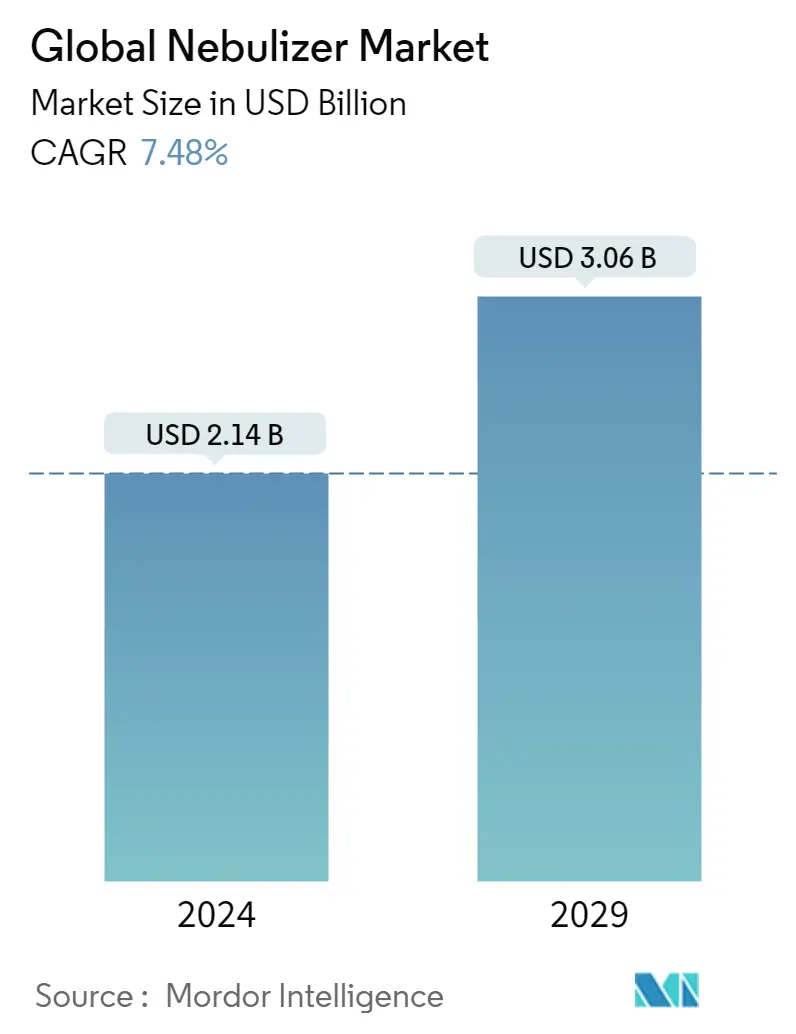Market Size of Global Nebulizer Industry

| Study Period | 2019 - 2029 |
| Market Size (2024) | USD 2.14 Billion |
| Market Size (2029) | USD 3.06 Billion |
| CAGR (2024 - 2029) | 7.48 % |
| Fastest Growing Market | Asia Pacific |
| Largest Market | North America |
Major Players
*Disclaimer: Major Players sorted in no particular order |
Need a report that reflects how COVID-19 has impacted this market and its growth?
Nebulizer Market Analysis
The Global Nebulizer Market size is estimated at USD 2.14 billion in 2024, and is expected to reach USD 3.06 billion by 2029, growing at a CAGR of 7.48% during the forecast period (2024-2029).
The COVID-19 pandemic had a significant impact on the nebulizer market globally. The article titled "Impact of COVID-19 on people with asthma: a mixed methods analysis from a UK-wide survey" published in January 2022 stated that there was an increased inhaler use and worse asthma management in patients with COVID-19, compared with those not reporting COVID-19. Moreover, the article published in PubMed Central under the title "Guidance on nebulization during the current COVID-19 pandemic" in January 2021 stated that patients were hesitant about utilizing inhalation drugs that were thought to be possible sources of viral transmission and immunosuppression because they were aware of the possibility of airborne transmission of SARS-CoV-2. Patients with asthma or chronic obstructive pulmonary disease (COPD), however, should continue taking all inhaled drugs as directed. While some researchers do not rule out the possibility that nebulizer treatments may increase the risk of infection transmission via droplet nuclei and aerosols, it appears that inhalers, including pressurized metered-dose inhalers (pMDI), dry powder inhalers (DPI), or soft mist inhalers (SMIs), have a low risk of contamination. Thus, COVID-19 had a notable impact on the nebulizer market.
Certain factors are driving the market growth, which includes rising incidences of chronic respiratory diseases, increasing demand for home healthcare devices, and a rising geriatric population base. Tobacco smoking is one of the primary causes of the increase in respiratory diseases worldwide. As per the World Health Organization, May 2022 update, in 2020, 22.3% of people worldwide used tobacco, of which 36.7% reported were men and 7.8% reported were women. Additionally, the substantial increase in the prevalence and incidence of asthma has led to an increase in the patient population. For instance, as per the data from national and state surveillance systems administered by the Centers for Disease Control and Prevention (CDC), in May 2022, the prevalence of asthma was 25,257,138 in 2020. Furthermore, the American Cancer Society estimated that lung and bronchus cancer incidence in the United States in 2022 was 236,740. Such a high burden of lung cancer, asthma, and other respiratory diseases creates a need for nebulizers and hence drives the growth of the market.
Additionally, the launch of technically advanced nebulizers in different parts of the world is also propelling the growth of the market. For instance, in December 2020, AireHealth received 510(k) clearance from the United States Food and Drug Administration (FDA) for its connected nebulizer branded as VitalMed. The device is a portable, electronic vibrating mesh nebulizer designed to nebulize liquid medications for inhalation by a patient in and out of the home. Such approvals are propelling the growth of the market.
Thus, owing to the abovementioned factors, the market is expected to project growth over the forecast period. However, drug loss during drug delivery is the major restraining factor for the market studied.
